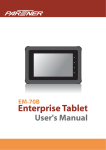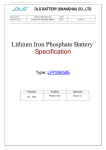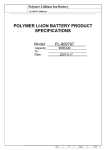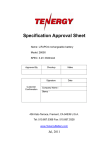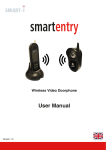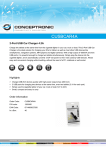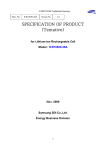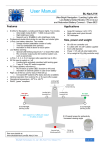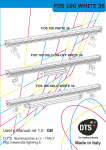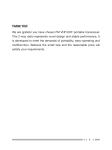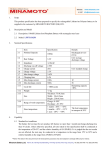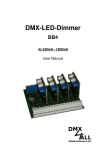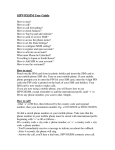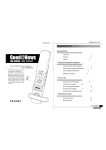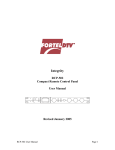Download Lithium Ion Battery Specifications Model: LFP18650
Transcript
Lithium Ion Battery Specifications Type: Cylindrical Lithium Iron Phosphate Battery Model: LFP18650-1500 AA Portable Power Corp Prepared by Checked by 1 Approved by Product Specifications Type -------------Cylindrical Lithium Iron Phosphate Battery Model --------------------------------LFP18650-1500 Dimension (Including shrink sleeve/label) h Diameter, d ---------------------------- 18.1±0.2mm Height , h ------------------------------- 64.5±1.0mm Mass -------------------------------------- Nominal voltage --------------------------- 41g (Approx) 3.2V Capacity 0.2C discharge Nominal ------------------------------- 1400 mAh Maximum ------------------------------ 1500 mAh CV Charge voltage Recommend --------------------------------------- 3.65V Maximum ------------------------------------------ 3.90V Maximum continuous charge current---------- 1400 mA Maximum discharge current d Continuous-------------------------------------- 4200mA Pulse(10Sec)-------------------------------- 8400mA Discharge cut-off voltage ------------------ 2.5V Internal impedance (23±2°C)-------------- ≤ 50mΩ Operation temperature Discharge-------------------------------------Charge ------------------------------------------- -20-60°C 0-45°C Storage temperature non-condensing Within 1month ----------------------------- 0-45°C 1-3months ---------------------------------- 0-35°C 3-12months -------------------------------- 0-25°C 2 1. Scope This specification shall be applied to Lithium ion rechargeable battery cell 2. Testing environment Unless otherwise specified, all tests stated in this document shall be performed at 23±2°C. 3. Performance and test conditions Standard charge: 0.5C=700mA constant current (CC) charge to 3.65V, followed by 3.65V constant voltage (CV) charge until current taper to ≤0.01C. 。 Standard discharge: 0.5C=700mA CC discharge to the end of discharge voltage. No. 3.1 Test item Test conditions No prominent stain and deformation, nor damage. Outside Appearance Visual check Outside Dimensions Vernier clippers Open circuit voltage at delivery Voltage within 1 week after delivery 3.2 3.3 3.4 Requirements Diameter 18.1±0.2 mm Height 64.5±1.0 mm 3.2V or more Internal resistance at delivery The cell impedance shall be measured by AC method (1kHz) within 1 week after delivery. 50mΩ or less Nominal capacity At standard charging(CH) and discharging at 0.2C Temperature-rat e performance 1)Standard CH at R.T 3.5 3.6 1400mAh or more Keep batteries in a icebox with ambient temperature of -20°C for 4 hours. DCH at 0.2C to the end of DCH voltage at -20°C, Calculate the capacity ratio with the nominal capacity. 2)Standard CH at R.T 3 Capacity ratio ≥50% Keep batteries in a icebox with ambient temperature of 0°C for 4 hours. Capacity ratio ≥75% Standard DCH to the end of DCH voltage at 0°C; Calculate the capacity ratio with the nominal capacity. 3)Standard CH at RT Keep batteries in a icebox with ambient temperature of 60°C for 4 hours. Standard DCH to the end of DCH voltage at 60°C; Calculate the capacity ratio with the nominal capacity. Capacity ratio ≥95% 3.7 Cycle Life 1000 cycles of standard CH and standard DCH at 0.2C. 4. The ratio of discharge capacity at the last and the first cycle ≥80% Mechanical Performances No. 4.1 4.2 Test Item Drop Test Conditions Specifications The cell shall be standard charged and then dropped onto No fire, nor explosion. hard wood from the height of 75 cm in 3 directions X, Y, and Z once at each direction. Vibration No explosion and flame, no deformation. Possible to be charged and discharged. A standard charged cell shall be vibrated as specified hereunder. Vibration waveform: sinusoidal. Frequency: 16.7Hz. Test time: 1 hours. Vibration direction: arbitrary. Total amplitude: 1mm. After vibration application, the cell shall be standard CH, and then standard DCH. 4 5. Safety Evaluation No. 5.1 5.2 5.3 5.4 Test Item External short circuit Test Conditions The cell shall be standard charged. The plus and minus terminals of the cell shall be short circuited with a wire having 50mΩ or less resistance, and left for 1 hour. Specifications No explosion and flame, nor deformation. Over charge After standard charged, the cell shall be charged for 2.5 No fire, nor explosion hours using 10V, 1400mA power supply. Over discharge The cell shall be standard charged, and discharged with 50Ω resistor load for 24 hours. Hot Oven Test No explosion and flame, nor deformation. No fire, nor explosion The charged batteries are heated in a gravity convection or circulating air oven. The temperature of the oven is to be raised at a rate of 5±2°C per minute. The oven is to remain for 30 minutes at 150±2°C before the test is discontinued. 5.5 5.6 Nail Test A nail with a diameter of 2.5 to 5mm is penetrated vertically through the center of the fully charged battery. Impact test No fire, nor explosion No fire, nor explosion A test sample battery is to be placed on a flat surface. A 5/8 inch (15.8mm) diameter bar is to be placed across the center of the sample. A 20 pound (9.1kg) weight is to be dropped from a height of 24+1 inch (610mm) onto the sample. 5.7 Crush test No fire, nor explosion The force for the crushing is to be applied by a hydraulic ram with a 1.25 inch (32mm) diameter piston. The crushing is to be continued until a pressure reading of 17.2MPa is reached on the hydraulic ram, applied force of 13kN. 6. Welding allowable part on a cell Welding is not allowed on cell side wall. 7. Insulation Can top face (positive terminal) and side is covered with insulation tubing. 5 8. Charge State of Battery before shipment Approximately 30% charged baseline. 9. Storage Store the battery at low temperature (below 20°C is recommended), low humidity, no dust and no corrosive gas atmosphere. 10. Warranty Our corporation will repair the cells or batteries for free or replace with new product if there is any fault which is due to material or workmanship during 3 months from the date of delivery. Handling Precaution and Prohibitions of Lithium Ion Rechargeable Cells and Batteries [ Danger!] ■ Electrical misusage Use dedicated charger. Use or charge the battery only in the dedicated application. Don't charge the battery reversely. ■ Environmental misusage Don't leave the battery near the fire or a heated source. Don't throw the battery into the fire. Don't charge or use the battery in a car or similar place where inside of temperature may be over 60°C. Don't immerse, throw, wet the battery in water / seawater. . ■ Others Don't store the battery in a pocket or a bag together with metallic objects such as keys, necklaces, hairpins, coins, or screws. Don't short circuit (+) and (-) terminals with metallic object intentionally. 6 Don't heat partial area of the battery with heated objects such as soldering iron. Don't hit with heavy objects such as a hammer, weight. Don't step on the battery and throw or drop the battery on the hard floor to avoid mechanical shock. Don't disassemble the battery or modify the battery design including electric circuit. Don't use seriously scared or deformed battery. Don't put the battery into a microwave oven, dryer or high-pressure container. Don't use or assemble the battery with other makers' batteries, different types and/or models of batteries such as dry batteries, nickel-metal hydride batteries, or nickel-cadmium batteries. [ Warning! ] Don't use or assemble old and new batteries together. Stop charging the battery if charging isn't completed within the specified time. Stop using the battery if the battery becomes abnormally hot, discoloration, deformation, or abnormal conditions are detected during use, charge, or storage. Keep away from fire immediately when leakage or foul odors are detected. If liquid leaks onto your skin or cloths, wash well with fresh water immediately. If liquid leaking from the battery gets into your eyes, don't rub your eyes and wash them with clean water and go to see a doctor immediately. If the terminals of the battery become dirty, wipe with a dry cloth before using the battery. The battery can be used within the following temperature ranges. Don't exceed these ranges. Charge temperature ranges: 0~45°C Discharge Temperature ranges: -20~60°C Store the battery at temperature below 60°C [ Caution! ] ■ Electrical misusage Battery must be charged with constant current-constant voltage (CC/CV). Charge current must be controlled by specified value in Cell specification. 7 Discharge current must be controlled by specified value in Cell’s specification. Cut-off voltage of discharging must be over 2.25V/cell. Keep the battery away from babies and children to avoid any accidents such as swallow. If younger children use the battery, their guardians should explain the proper handling method and precaution before using. Before using the battery, be sure to read the user's manual and precaution of it's handling. Before using charger, be sure to read the user's manual of the charger. Before installing and removing the battery from application, be sure to read user's manual of the application. Replace the battery when using time of battery becomes much shorter than usual. Cover terminals with insulating tape before proper disposal. If the battery is needed to be stored for a long period, battery should be removed from the application and stored in a place where humidity and temperature are low. While the battery is charged, used and stored, keep it away from object materials with static electric chargers. Design of positioning the battery pack in application and charger To prevent the deterioration of the battery performance caused by heat, battery shall be positioned away from the area where heat is generated in the application and the charger. Please email us at [email protected] or call 510-525-2328 when you need any help including safety concerns. 8








